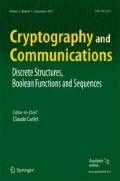Abstract
Due to the wide applications in communications, data storage and cryptography, linear codes have received much attention in the past decades. As a subclass of linear codes, minimal linear codes can be used to construct secret sharing with nice access structure. The objective of this paper is to construct new classes of minimal binary linear codes with \(w_{\min \limits }/w_{\max \limits }\leq 1/2\) from preferred binary linear codes, where \(w_{\min \limits }\) and \(w_{\max \limits }\) denote the minimum and maximum nonzero Hamming weights in \(\mathcal {C}\) respectively. Firstly, we introduce a concept called preferred binary linear codes and a class of minimal binary linear codes with \(w_{\min \limits }/w_{\max \limits }\leq 1/2\) can be deduced from preferred binary linear codes. As an application of preferred binary linear codes, we get a new class of six-weight minimal binary linear codes with \(w_{\min \limits }/w_{\max \limits }< 1/2\) from a known class of five-weight preferred binary linear codes. Secondly, by employing vectorial Boolean functions, we construct two new classes of preferred binary linear codes and, consequently, these two new classes of preferred binary linear codes can generate two new classes of minimal binary linear codes with \(w_{\min \limits }/w_{\max \limits }\leq 1/2\) and large minimum distance.
Similar content being viewed by others
References
Anderson, R.J., Ding, C., Helleseth, T., Kløve, T.: How to build robust shared control systems. Des. Codes Cryptogr. 15(2), 111–124 (1998). https://doi.org/10.1023/A:1026421315292
Ding, K., Ding, C.: A class of two-weight and three-weight codes and their applications in secret sharing. IEEE Trans. Inf. Theory 61(11), 5835–5842 (2015). https://doi.org/10.1109/TIT.2015.2473861
Ding, C., Wang, X.: A coding theory construction of new systematic authentication codes. Theor. Comput. Sci. 330(1), 81–99 (2005). https://doi.org/10.1016/j.tcs.2004.09.011
Delsarte, P., Levenshtein, V. I.: Association schemes and coding theory. IEEE Trans. Inf. Theory 44(6), 2477–2504 (1998). https://doi.org/10.1109/18.720545
Ashikhmin, A., Barg, A.: Minimal vectors in linear codes. IEEE Trans. Inf. Theory 44(5), 2010–2017 (1998)
Ding, C.: Linear codes from some 2-designs. IEEE Trans. Inf. Theory 61(6), 3265–3275 (2015). https://doi.org/10.1109/TIT.2015.2420118
Tang, C., Li, N., Qi, Y., Zhou, Z., Helleseth, T.: Linear codes with two or three weights from weakly regular bent functions. IEEE Trans. Inf. Theory 62(3), 1166–1176 (2016)
Tang, C., Qi, Y., Huang, D.: Two-weight and three-weight linear codes from square functions. IEEE Commun. Lett. 20(1), 29–32 (2016). https://doi.org/10.1109/LCOMM.2015.2497344
Heng, Z., Yue, Q.: A class of binary linear codes with at most three weights. IEEE Commun. Lett. 19(9), 1488–1491 (2015). https://doi.org/10.1109/LCOMM.2015.2455032
Heng, Z., Yue, Q., Li, C.: Three classes of linear codes with two or three weights. Discret. Math. 339(11), 2832–2847 (2016). https://doi.org/10.1016/j.disc.2016.05.033
Chang, S., Hyun, J. Y.: Linear codes from simplicial complexes. Linear codes from simplicial, pp. 1–15 (2017)
Ding, C., Heng, Z., Zhou, Z.: Minimal binary linear codes. IEEE Transactions on Information Theory (2018)
Zhang, W., Yan, H., Wei, H.: Four families of minimal binary linear codes with wmin/wmax ≤ 1/2. Appl. Algebra Eng. Commun. Comput. 30(2), 175–184 (2019)
Bartoli, D., Bonini, M.: Minimal linear codes in odd characteristic. IEEE Trans. Inf. Theory 65(7), 4152–4155 (2019)
Bonini, M., Borello, M.: Minimal linear codes arising from blocking sets. arXiv:1907.04626 (2019)
Heng, Z., Ding, C., Zhou, Z.: Minimal linear codes over finite fields. Finite Fields Appl. 54, 176–196 (2018)
Ding, C.: A construction of binary linear codes from Boolean functions. Discret. Math. 339(9), 2288–2303 (2016). https://doi.org/10.1016/j.disc.2016.03.029
Li, C., Yue, Q., Fu, F. W.: A construction of several classes of two-weight and three-weight linear codes. Applicable Algebra in Engineering, Communication and Computing, pp. 1–20 (2016)
Mesnager, S.: Linear codes with few weights from weakly regular bent functions based on a generic construction. Cryptography and Communications, pp. 1–14. https://doi.org/10.1007/s12095-016-0186-5 (2015)
Xu, G., Cao, X., Xu, S.: Two classes of p-ary bent functions and linear codes with three or four weights. Cryptogr. Commun. 9(1), 117–131 (2017)
Zhou, Z., Li, N., Fan, C., Helleseth, T.: Linear codes with two or three weights from quadratic bent functions. Des. Codes Cryptogr. 81(2), 283–295 (2016). https://doi.org/10.1007/s10623-015-0144-9
Nyberg, K.: Perfect Nonlinear S-Boxes. In: Advances in Cryptology<a̱EUROCRYPT< 91, pp. 378–386. Springer (1991)
Carlet, C., Ding, C.: Nonlinearities of S-boxes. Finite Fields Appl. 13(1), 121–135 (2007)
Wadayama, T., Hada, T., Wakasugi, K., Kasahara, M.: Upper and lower bounds on maximum nonlinearity of n-input m-output Boolean function. Des. Codes Crypt. 23(1), 23–34 (2001)
Tang, D., Carlet, C., Zhou, Z.: Binary linear codes from vectorial Boolean functions and their weight distribution. Discret. Math. 340(12), 3055–3072 (2017)
Acknowledgments
We would like to thank the anonymous reviewers for their valuable suggestions and comments, which improved the quality of our paper. The work of Deng Tang was supported by the National Natural Science Foundation of China (grants 61872435 and 61602394).
Author information
Authors and Affiliations
Corresponding author
Additional information
Publisher’s note
Springer Nature remains neutral with regard to jurisdictional claims in published maps and institutional affiliations.
This article is part of the Topical Collection on Special Issue on Sequences and Their Applications
Rights and permissions
About this article
Cite this article
Tang, D., Li, X. A note on the minimal binary linear code. Cryptogr. Commun. 12, 375–388 (2020). https://doi.org/10.1007/s12095-019-00412-3
Received:
Accepted:
Published:
Issue Date:
DOI: https://doi.org/10.1007/s12095-019-00412-3


